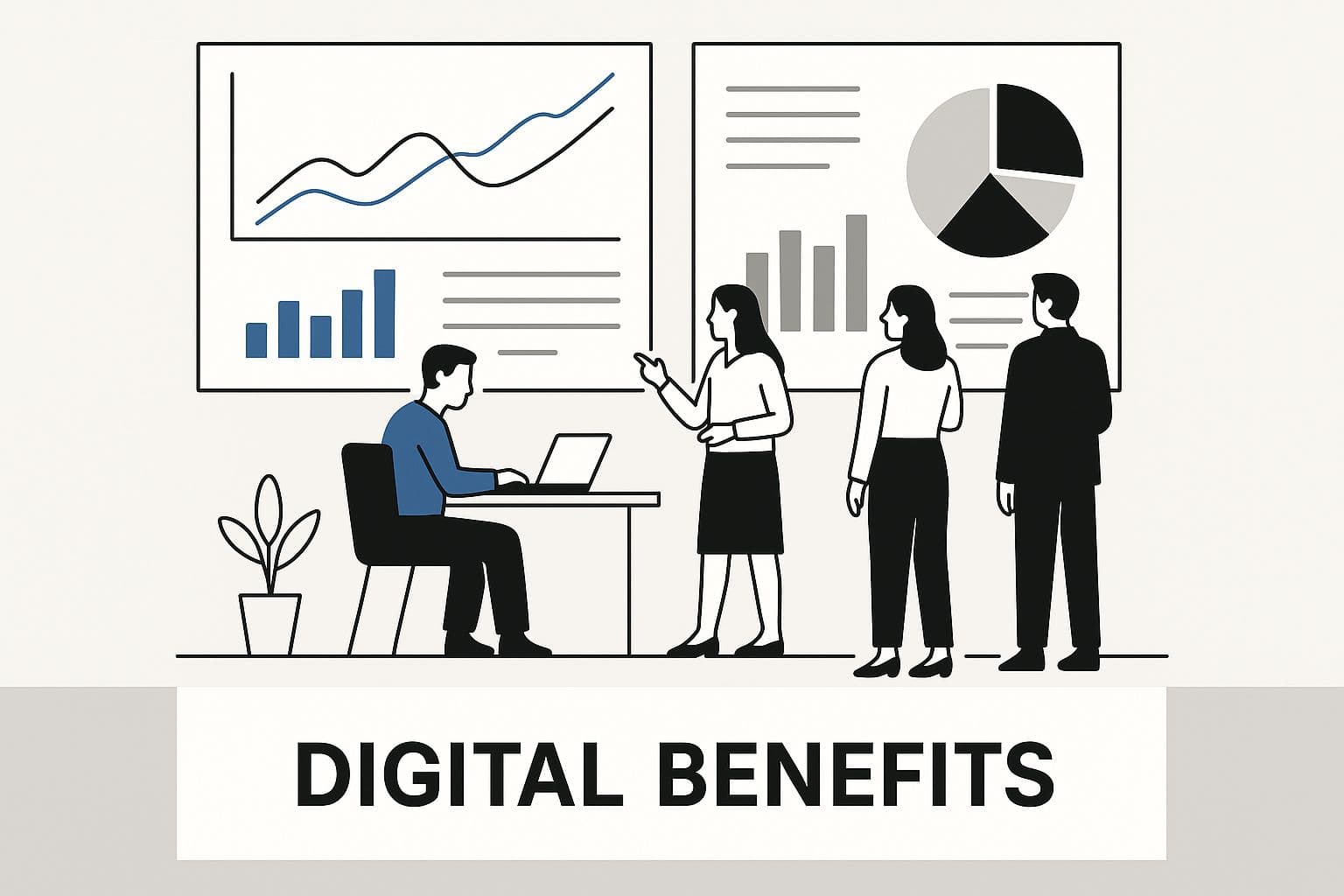A digital transformation strategy is your company's detailed plan for using technology to fundamentally change how you operate and deliver value to customers. It’s not just about buying the latest software; it's a deep rethinking of your business model, culture, and customer experiences, where your business goals always drive your technology choices.
What is a Digital Transformation Strategy, Really?
Let’s cut through the jargon. Think of it like this: adopting a new piece of software is like redecorating a room. It looks different, but the house's foundation remains the same. A true digital transformation is more like a full home renovation—you’re rebuilding the foundation to be more modern, efficient, and valuable for the future.
This strategic plan is a comprehensive blueprint, not a simple IT project. It aligns technology with your core business objectives, making sure every digital initiative pushes the company toward a specific, desired outcome. It answers the big questions: Why are we changing? What do we need to change? And how will we get there?
Digital Transformation Versus Digitalization
It's easy to confuse digital transformation with a much simpler concept: digitalization. Digitalization is about taking an existing process and making it digital. Transformation is about rethinking the process entirely.
For example, switching from paper invoices to PDFs is digitalization. Building an automated, AI-powered accounts payable system that analyzes spending trends and gives you real-time financial insights? That's transformation.
The table below breaks down the key differences:
Simply put, digitalization is about doing the same things better, while digital transformation is about doing new things that were never possible before.
This distinction is critical. Without a guiding strategy, companies often end up with a messy collection of disconnected digital tools that don't deliver real value. With one, technology becomes the engine for real business evolution, driving efficiency, innovation, and a much stronger competitive edge.
Why It Matters Now More Than Ever
Having a clear strategy isn't just a good idea anymore; it's essential for survival. As of 2024, over 90% of organizations are working on some form of digital initiative, a massive jump from just 50% in 2018.
This shift is fueled by intense competition and new technology, with cloud computing and AI leading the way. For instance, 92% of business leaders report using cloud technologies, and 77% are exploring AI to improve how they work. You can find more insights about this global shift from Mooncamp.
A solid strategy also shapes how your company manages information. To make smart, data-driven decisions, you need effective ways to capture, share, and use what your organization knows. This is where a strong approach to information becomes crucial. For a deeper dive, you might be interested in our guide on what is knowledge management and its key strategies.
Ultimately, your strategy is the roadmap that ensures all your digital efforts work together, have a clear purpose, and create lasting value.
The Four Pillars of a Winning Strategy
A solid digital transformation strategy isn't just about bolting on new technology. Think of it like building a house—it needs a strong foundation and several key pillars to hold everything up. If you neglect one, the whole structure becomes unstable. A transformation that's only skin-deep won't last.
To build a strategy that actually creates lasting change, you need to focus on four critical areas that all work together. Each one tackles a different part of your business, making sure your digital efforts create value from every possible angle.
This infographic breaks down how these pillars connect to real-world business benefits, showing a clear path from strategy to successful outcomes.

As you can see, a strategy that accounts for customers, operations, and your internal culture is the only way to achieve meaningful digital growth and get a leg up on the competition.
Reinventing the Customer Experience
This pillar is all about your customers. It means using digital tools to make every interaction they have with you feel seamless, personal, and genuinely helpful. The goal is to stop thinking in terms of one-off transactions and start building real, lasting relationships.
Today’s customers expect things to be easy and tailored to them. A smart digital strategy meets them where they are by:
- Creating Omnichannel Journeys: Letting customers move smoothly between your website, mobile app, social media, and even physical stores without missing a beat.
- Leveraging Data for Personalization: Using what you know about your customers to offer spot-on recommendations, relevant marketing, and customized support.
- Implementing Self-Service Options: Giving customers the power to solve their own problems with tools like AI chatbots and easy-to-search knowledge bases.
Optimizing Operational Processes
The second pillar looks inward at how your company actually gets work done. It’s all about using technology to make your internal processes faster, smarter, and way more efficient. This is where things like automation and data-driven insights really shine.
By redesigning how you operate, you can get rid of frustrating bottlenecks and free up your people to focus on work that truly matters. Key moves here often include:
- Automating Repetitive Tasks: Using tools like Robotic Process Automation (RPA) to take over mind-numbing work like data entry or processing invoices.
- Connecting Disparate Systems: Tying different software platforms together so everyone is working from the same information, breaking down those annoying silos between departments.
- Using Analytics for Decision-Making: Setting up dashboards that show what’s happening in real-time, helping leaders make better decisions, faster.
Innovating Your Business Model
This might be the boldest pillar of them all. It’s not just about doing what you already do better; it’s about finding entirely new ways to create value. You’re using technology to open up new revenue streams or maybe even jump into completely new markets.
For instance, a classic manufacturing company could start putting IoT sensors on its equipment. Suddenly, they're not just selling machines—they're selling predictive maintenance services, a brand-new, data-fueled business. This pillar takes guts and a willingness to question everything you thought you knew about your industry.
Nurturing People and Culture
Finally, we get to the most important pillar: the human one. Technology is just a tool. At the end of the day, it’s your people who make or break any transformation. This pillar is all about building a culture that embraces change, encourages collaboration, and never stops learning.
Without the right culture, the fanciest tech in the world will just gather dust. A successful strategy depends on:
- Leadership Buy-In: It has to start at the top. Leaders need to be the biggest champions of the new vision and lead by example.
- Upskilling and Reskilling: You have to invest in training to give your employees the skills they need to thrive in their new roles.
- Fostering Psychological Safety: Creating an environment where people feel safe enough to try new things, fail, learn from it, and speak up with bold ideas.
Together, these four pillars give you a balanced blueprint for a truly comprehensive digital transformation. By focusing on each one, you ensure you’re not just launching another tech project—you’re driving a genuine evolution of your entire business.
The Tech That Makes Transformation Happen
A digital transformation strategy isn't just a vision; it's built on a stack of powerful, interconnected technologies. These aren't just buzzwords. They are the actual tools that allow a business to reinvent itself from the ground up. Knowing how they fit together is the key to making smart investments that actually push your goals forward.
Think of it like building a high-performance car. You need an engine (AI), a flexible chassis (Cloud), a network of sensors (IoT), and a sophisticated fuel system (Big Data). Each component is impressive on its own, but when they work together, you create something with incredible speed and agility. That’s the kind of ecosystem that fuels a modern company.
This diagram shows how different digital technologies come together to create new capabilities across an entire organization.

As you can see, it's not about one single piece of tech. It’s a fusion of things like cloud, mobile, and social platforms, all running on a solid foundation of data and analytics.
Artificial Intelligence and Machine Learning
Artificial Intelligence (AI) and its partner, Machine Learning (ML), are the brains of the whole operation. They do more than just automate tasks—they spot patterns, make surprisingly accurate predictions, and get smarter over time, all without a human explicitly telling them what to do. This is what turns a mountain of raw data into intelligent, decisive action.
AI is the engine behind so many of today's big business shifts. It’s no surprise that global IT spending is expected to hit a staggering $5.7 trillion in 2025. A huge chunk of that is going toward AI, especially generative AI. In fact, about 80% of organizations are planning to use generative AI in 2025, and businesses leading the digital charge are nearly 30% more likely to boost their AI funding compared to their peers. And it's working—over 56% of CEOs are already seeing profits climb thanks to their digital projects. For a deeper dive into these numbers, TekSystems' 2025 outlook on digital transformation is a great resource.
So, what does this look like in the real world?
- Predictive Analytics: Figuring out what customers will buy next, forecasting sales trends, or even predicting when a piece of machinery is about to fail.
- Personalization Engines: The magic behind Netflix or Amazon recommendations that seem to know exactly what you want.
- Natural Language Processing (NLP): This powers the chatbots and voice assistants that can actually understand and talk back to you. To learn more, take a look at our complete guide on what is Natural Language Processing.
Cloud Computing
If AI is the brain, then cloud computing is the powerful, flexible backbone that holds everything up. Platforms like Amazon Web Services (AWS), Microsoft Azure, and Google Cloud give you access to immense computing power and storage on demand. You no longer have to spend a fortune on physical servers you might not even use.
This "as-a-service" model makes companies incredibly nimble. A team can spin up the resources for a new project in minutes, not months.
This foundation is non-negotiable for storing the enormous datasets needed for Big Data and running the power-hungry algorithms that make AI work.
Internet of Things (IoT)
The Internet of Things (IoT) is the nervous system of a digital business. It’s the massive network of physical devices—from factory machines to smart thermostats—that are embedded with sensors and software, constantly collecting and sharing data from the real world.
For example, a manufacturer can place IoT sensors on its assembly line equipment. These sensors track everything from temperature and vibration to output, streaming that data to the cloud in real-time. This allows them to predict when a machine needs maintenance before it breaks down, saving a huge amount of time and money.
Big Data Analytics
Finally, Big Data Analytics is how you make sense of all this information. It's the process of sifting through massive, messy datasets to find the hidden patterns, connections, and golden nuggets of insight that guide smart business decisions.
This is the glue that connects all the other technologies. Data flows from IoT sensors, gets stored in the cloud, and is then analyzed by AI and ML algorithms to produce insights you can actually use. It’s what helps a business stop reacting to what happened yesterday and start proactively planning for what’s coming tomorrow.
How to Build Your Transformation Roadmap
Okay, you get what a digital transformation strategy is and you understand the technology. Now for the hard part: building your own plan. A roadmap isn't some rigid document set in stone; it's a living guide that maps out the journey from where you are today to where you need to be tomorrow.
Think of it like planning a cross-country road trip. You wouldn’t just jump in the car and start driving west, hoping for the best. You'd pick a destination, make sure the car is up for the journey, map out your key stops, and decide which routes give you the right mix of speed and scenery. Your digital transformation roadmap is exactly the same—it gives your efforts direction and purpose.
Start with a Clear Vision
Before you touch a single piece of technology, you have to define what winning looks like. Your vision is your North Star. It’s the ultimate destination that keeps everyone moving in the same direction, and it has to connect your digital efforts directly to real business goals.
Don’t settle for a vague goal like "become more digital." Get specific. For a retailer, a powerful vision might be: "Create a seamless, personalized shopping experience across every channel to boost customer loyalty by 25% within three years." Suddenly, everyone has a clear target.
To get to that level of clarity, ask some tough questions:
- What business problem are we actually trying to solve? Are we losing ground to competitors, drowning in inefficiency, or just failing to give customers what they want?
- Where do we want this company to be in five years? And how, specifically, will technology help us get there?
- What does an amazing customer or employee experience look like in our world?
Assess Your Current Digital Maturity
Once you know where you're going, you need an honest look at where you're starting from. This means taking a candid inventory of your current digital capabilities—your people, your processes, and your tech—to see what’s working and what’s holding you back.
This is much more than a simple IT audit. It’s about gauging your entire organization's readiness for change. You need to know where your data is hiding, which processes are stuck in the dark ages of manual work, and what skills your teams have versus the ones they’ll need.
Secure Leadership Buy-In and Build a Team
You absolutely cannot do this alone. A transformation initiative needs loud and visible support from the very top. Your executive team can’t just sign the checks; they need to become the biggest champions of the vision, constantly communicating its importance and leading the change by example. Microsoft’s own transformation famously relied on CEO Satya Nadella personally driving a cultural shift toward a "growth mindset."
Beyond the C-suite, you need to pull together a cross-functional team. This isn't just an IT project. Get people from marketing, operations, sales, and HR in the same room. Their different viewpoints are crucial for making sure the roadmap serves the whole business, not just one department. Using tools for efficient meeting automation can be a lifesaver here, keeping these diverse teams aligned on big-picture goals instead of getting lost in administrative quicksand.
Prioritize Initiatives and Create a Phased Plan
Trying to do everything at once is a surefire way to fail. You can't boil the ocean. Instead, you need to break your grand vision down into a series of smaller, more manageable projects. The key is to prioritize them based on two simple factors: business impact and ease of implementation.
Always start with a few quick wins. These are the projects that are relatively easy to pull off but deliver tangible value fast. For instance, automating a single, tedious report could free up dozens of hours for a team. That small victory proves the value of the strategy and builds the momentum you’ll need for the bigger, tougher projects down the road.
Your phased plan should look something like this:
- Phase 1 (Months 1-6): Lay the foundation and grab those quick wins. This could be launching a new CRM, automating a key back-office task, or training employees on new collaboration software.
- Phase 2 (Months 7-18): Tackle the more complex stuff. Now you’re ready to integrate disconnected systems, launch a new e-commerce platform, or start using data analytics to personalize customer experiences.
- Phase 3 (Months 19+): Aim for true innovation. This is where you work on the big-picture goals, like developing brand-new digital products or exploring entirely new business models that your new capabilities make possible.
By breaking the journey into clear stages, you make the whole thing feel less intimidating. It also gives you plenty of chances to learn, adjust your course, and celebrate progress along the way.
Navigating the Inevitable Bumps in the Road
Embarking on a digital transformation journey is exciting, but let's be real—it’s never a straight line from A to B. The path is almost always littered with obstacles that can bog you down or, in some cases, derail the whole effort. Knowing what these common pitfalls look like before you run into them is the best way to steer clear.

A lot of organizations stumble right out of the gate by treating transformation like an IT project. It’s not just about a software upgrade; it's a fundamental shift in how your business operates. This simple misunderstanding is often the root cause of some very predictable, and very damaging, mistakes.


